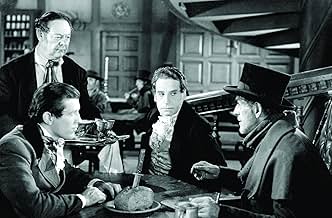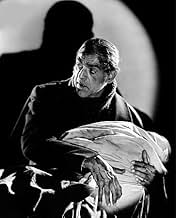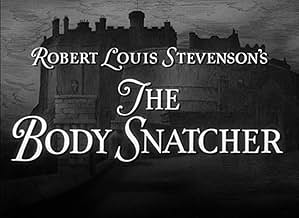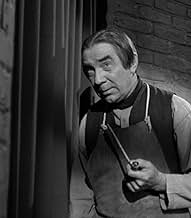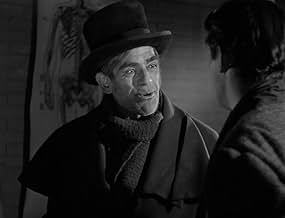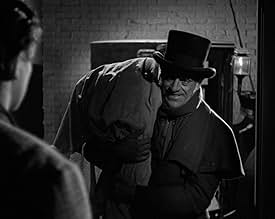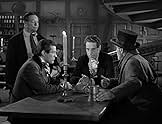IMDb-BEWERTUNG
7,3/10
10.916
IHRE BEWERTUNG
Ein skrupelloser Arzt und sein junger Student werden ständig von ihrem mörderischen Lieferanten illegaler Leichen belästigt.Ein skrupelloser Arzt und sein junger Student werden ständig von ihrem mörderischen Lieferanten illegaler Leichen belästigt.Ein skrupelloser Arzt und sein junger Student werden ständig von ihrem mörderischen Lieferanten illegaler Leichen belästigt.
- Regie
- Drehbuch
- Hauptbesetzung
- Auszeichnungen
- 3 Nominierungen insgesamt
Paula Corday
- Mrs. Marsh
- (as Rita Corday)
Ted Billings
- Townsman
- (Nicht genannt)
Bobby Burns
- Mourner
- (Nicht genannt)
Robert Clarke
- Richardson - Medical Student
- (Nicht genannt)
Aina Constant
- Maidservant
- (Nicht genannt)
Mary Gordon
- Mrs. Mary McBride
- (Nicht genannt)
Bobbie Hale
- Townsman
- (Nicht genannt)
Carl Kent
- Gilchrist - Medical Student
- (Nicht genannt)
Milton Kibbee
- Dan
- (Nicht genannt)
Ethan Laidlaw
- Pub Patron
- (Nicht genannt)
Kermit Maynard
- Townsman
- (Nicht genannt)
Empfohlene Bewertungen
What can you say about Boris Karloff? He attacks this role with evil zest. I have not seen a lot of his work, but I was extremely impressed with his portrayal of Cabman Gray, the medical school's grave robber. (among other things) The modern horror genre simply focuses on gore, and doesn't allow characters like Gray, or actors like Karloff flourish, and that's too bad.
SPOILERS.
You don't really want to miss this one unless you've been weaned on Arnold Schwarzenegger action movies or Nightmare on Elm Street, Part Twenty, the PreSequal. There is horror galore but served up with frisson.
One can't help admiring Val Lewton and his crew at RKO, working on tiny budgets, but producing miniature gems. It's like painting a masterpiece on the head of a pin. Robert Wise was his director here but the credit goes mainly to producer Lewton, the Russian master of Who Torok. Lewton was insistent on authenticity. The songs we hear are contemporary Scottish folk songs and the wardrobe as close to the real thing as they could get. And Lewton saw to it that "reality" was evoked by small items from the prop department and small incidents on screen. At night, for instance, in order to see something in a dark basement, the doctor calls out for someone to bring a candle. In a less thoughtful movie the deserted basement would have a couple of lanterns already lighted, or the set would be brightly lighted with no visible lanterns at all. A small thing, as I say.
But it's not just historical accuracy that makes Lewton's RKO pictures so appealing. His plots are rooted in time. And his scripts are -- how can one put this without sounding snotty? -- "literate". ("Oh, how we cozzened them!") I don't know how closely the dialogue sticks to Stevenson's original story but it works very well, partly because the actors are so competent. Stealing the dialogue isn't necessarily a bad thing when the words are good to begin with. John Huston lifted most of his dialogue for "The Maltese Falcon" directly from Hammett's novel. And Shakespeare ripped off whole sections of Plutarch's "Lives" for "Julius Caesar." Henry Daniell, like Robert Douglas, later became stereotyped as heavies in Errol Flynn swashbucklers, but Danielle has a far more complex role here -- proud of his medical skills but driven insane by that pride. The accents are mostly American, alas, but the performers at least LOOK right.
Then there is the plot. I know it sounds odd in a producer of horror movies but Lewton was a man of good taste. Driven to find a dead body to sell to Daniell, Karloff decides to murder a sweet-faced young blind girl who is a street singer. A modern movie would give us a bathtub full of blood. Here's what Lewton does. The little girl walks alone down a deserted cobblestone street at night, singing a melancholy tune as she goes. The camera is held on her as she walks under a bridge and disappears in the darkness on the other side. Without any cuts, Karloff's horse and coach enter the frame, plodding slowly along in the girl's wake. The coach disappears into the same darkness under the bridge. We hear the girl's carol cut off at the end of a note with a slight squeak. End of shot. It's a far more moving moment than a dozen multiple on screen slashings and throat cuttings and we haven't seen any of it.
The ending, however, is fairly explicit. Daniell, now mad, gallops furiously through the rainy night along muddy roads, the recently "resurrected" dead body bouncing along in the seat beside him. Instead of the dead woman he has just disinterred, the body is now that of Karloff, revealed only when lightning blindingly illuminates the crazily rocking coach.
"The Body Snatcher" doesn't have the easy shocks of some of Lewton's other works, like "The Curse of the Cat People," no "buses" as Lewton called them.
But there is a sense of evil throughout, or let's call it corruption, and it grows as the film moves quietly along. In its own way it's the equal of anything Lewton did before or after.
Outstanding.
You don't really want to miss this one unless you've been weaned on Arnold Schwarzenegger action movies or Nightmare on Elm Street, Part Twenty, the PreSequal. There is horror galore but served up with frisson.
One can't help admiring Val Lewton and his crew at RKO, working on tiny budgets, but producing miniature gems. It's like painting a masterpiece on the head of a pin. Robert Wise was his director here but the credit goes mainly to producer Lewton, the Russian master of Who Torok. Lewton was insistent on authenticity. The songs we hear are contemporary Scottish folk songs and the wardrobe as close to the real thing as they could get. And Lewton saw to it that "reality" was evoked by small items from the prop department and small incidents on screen. At night, for instance, in order to see something in a dark basement, the doctor calls out for someone to bring a candle. In a less thoughtful movie the deserted basement would have a couple of lanterns already lighted, or the set would be brightly lighted with no visible lanterns at all. A small thing, as I say.
But it's not just historical accuracy that makes Lewton's RKO pictures so appealing. His plots are rooted in time. And his scripts are -- how can one put this without sounding snotty? -- "literate". ("Oh, how we cozzened them!") I don't know how closely the dialogue sticks to Stevenson's original story but it works very well, partly because the actors are so competent. Stealing the dialogue isn't necessarily a bad thing when the words are good to begin with. John Huston lifted most of his dialogue for "The Maltese Falcon" directly from Hammett's novel. And Shakespeare ripped off whole sections of Plutarch's "Lives" for "Julius Caesar." Henry Daniell, like Robert Douglas, later became stereotyped as heavies in Errol Flynn swashbucklers, but Danielle has a far more complex role here -- proud of his medical skills but driven insane by that pride. The accents are mostly American, alas, but the performers at least LOOK right.
Then there is the plot. I know it sounds odd in a producer of horror movies but Lewton was a man of good taste. Driven to find a dead body to sell to Daniell, Karloff decides to murder a sweet-faced young blind girl who is a street singer. A modern movie would give us a bathtub full of blood. Here's what Lewton does. The little girl walks alone down a deserted cobblestone street at night, singing a melancholy tune as she goes. The camera is held on her as she walks under a bridge and disappears in the darkness on the other side. Without any cuts, Karloff's horse and coach enter the frame, plodding slowly along in the girl's wake. The coach disappears into the same darkness under the bridge. We hear the girl's carol cut off at the end of a note with a slight squeak. End of shot. It's a far more moving moment than a dozen multiple on screen slashings and throat cuttings and we haven't seen any of it.
The ending, however, is fairly explicit. Daniell, now mad, gallops furiously through the rainy night along muddy roads, the recently "resurrected" dead body bouncing along in the seat beside him. Instead of the dead woman he has just disinterred, the body is now that of Karloff, revealed only when lightning blindingly illuminates the crazily rocking coach.
"The Body Snatcher" doesn't have the easy shocks of some of Lewton's other works, like "The Curse of the Cat People," no "buses" as Lewton called them.
But there is a sense of evil throughout, or let's call it corruption, and it grows as the film moves quietly along. In its own way it's the equal of anything Lewton did before or after.
Outstanding.
This interesting story is adapted from a novel by Robert Louis Stevenson . It concerns John Gray (Boris Karloff) , he's a cabman who provides dead bodies for illegal medical research in charge of Dr. MacFarland (Henry Daniell) . Then Gray is blackmailed by MacFarland's servant (Bela Lugosi) . Meanwhile , his doctor assistant Donald (Russell Wade) tries to help a mother and her paralytic daughter , and for experiments , he asks for help John Gray in order to get corpses.
This is a fine , suspenseful and intriguing terror movie based on the actual characters of the nasty gravediggers Burke and Hare that have been adapted a number of times . Tension , horror, thriller appear lurking , menacing in graveyard , dark slums , home stairs , rooms and cementery . The film gets the expressionist German atmosphere , thanks to cameraman Robert De Grasse . He along with photographers Nicholas Musuruka and John Alton are the main artificers of noir cinema atmosphere . Casting is frankly outstanding . Terrific Boris Karloff as a sinister graverobber , he creates authentic frightening and panic , impressive Bela Lugosi , both of whom share the last creepy scenes together and Henry Daniell does an equally compelling turn . Usual musician RKO , Roy Webb , composes an adequate musical score with habitual musical director Bakaleinikoff . Exciting screenplay by Philip McDonald and Val Lewton -under pseudonym Carlos Keith- . The motion picture was well directed by Robert Wise and magnificently produced by Val Lewton . RKO's Lewton is a great producer of horror classics , such as : ¨Cat people¨, ¨Leopard man¨, ¨I walked with a Zombi¨,¨Ghost ship¨, among others . Rating : Better than average , well worth checking out. The tale will appeal to Boris Karloff fans and cinema classics buffs.
This is a fine , suspenseful and intriguing terror movie based on the actual characters of the nasty gravediggers Burke and Hare that have been adapted a number of times . Tension , horror, thriller appear lurking , menacing in graveyard , dark slums , home stairs , rooms and cementery . The film gets the expressionist German atmosphere , thanks to cameraman Robert De Grasse . He along with photographers Nicholas Musuruka and John Alton are the main artificers of noir cinema atmosphere . Casting is frankly outstanding . Terrific Boris Karloff as a sinister graverobber , he creates authentic frightening and panic , impressive Bela Lugosi , both of whom share the last creepy scenes together and Henry Daniell does an equally compelling turn . Usual musician RKO , Roy Webb , composes an adequate musical score with habitual musical director Bakaleinikoff . Exciting screenplay by Philip McDonald and Val Lewton -under pseudonym Carlos Keith- . The motion picture was well directed by Robert Wise and magnificently produced by Val Lewton . RKO's Lewton is a great producer of horror classics , such as : ¨Cat people¨, ¨Leopard man¨, ¨I walked with a Zombi¨,¨Ghost ship¨, among others . Rating : Better than average , well worth checking out. The tale will appeal to Boris Karloff fans and cinema classics buffs.
As of this writing, I have seen four of the nine Val Lewton DVD Horror Collection films and this one was, by far, the best.
Henry Daniell, Boris Karloff, Edith Atwater,Russell Wade, Sharyn Moffet and Bela Lugosi all acted well. I had forgotten that Karloff was a decent actor, not just some Frankenstein monster who couldn't deliver a line. He had a creepy voice, too, which lent itself nicely to horror films. I just found him fascinating here.
In addition, this movie had a well-known director, Robert Wise, and the story was adaption of a Robert Louis Steevenson. So, you see, this film had good bloodlines, pun intended. This was not some schlocky Ed Wood B-film. This movie is a high class affair.
I found it more of a crime story than anything else as a doctor (Daniell), trying to further his knowledge and needing human specimens (dead) to continue his research, has his graveyard supply cut off to him and then has to have his helper (Karloff) kill people to provide him the bodies. Meanwhile, a young and more moral student of the doctor, gets wind of what's happening and doesn't share his mentor's view that the "ends justify the means."
At any rate, this a keeper. Like the other Lewton films I've seen, it's well- photographed, too. I can only hope a few of the five I haven't seen yet are this good.
Henry Daniell, Boris Karloff, Edith Atwater,Russell Wade, Sharyn Moffet and Bela Lugosi all acted well. I had forgotten that Karloff was a decent actor, not just some Frankenstein monster who couldn't deliver a line. He had a creepy voice, too, which lent itself nicely to horror films. I just found him fascinating here.
In addition, this movie had a well-known director, Robert Wise, and the story was adaption of a Robert Louis Steevenson. So, you see, this film had good bloodlines, pun intended. This was not some schlocky Ed Wood B-film. This movie is a high class affair.
I found it more of a crime story than anything else as a doctor (Daniell), trying to further his knowledge and needing human specimens (dead) to continue his research, has his graveyard supply cut off to him and then has to have his helper (Karloff) kill people to provide him the bodies. Meanwhile, a young and more moral student of the doctor, gets wind of what's happening and doesn't share his mentor's view that the "ends justify the means."
At any rate, this a keeper. Like the other Lewton films I've seen, it's well- photographed, too. I can only hope a few of the five I haven't seen yet are this good.
This is unlike some of the other Val Lewton mystery/horror films from the 1940s in that it is a classic Gothic horror tale with a classic Gothic horror topic - 19th century grave robbing for the purpose of medical research. There's no wartime engineer married to a mysterious and troubled woman who is afraid she'll turn into a leopard if sexually aroused in THIS Lewton film! But I digress.
Dr. MacFarlane (Henry Daniells) is a famous surgeon and medical school professor in Edinburgh. He gives a job to medical school student Donald Fettes because, otherwise, Fettes will have to leave school because he can't afford tuition and his living expenses, and MacFarlane thinks Fettes has the makings of a fine doctor. But, among other things, the job involves the intake of cadavers for dissection. And those bodies are the product of graverobbing by cabman John Gray (Boris Karloff). Of course the graverobbing is bad enough, but it soon escalates to murder on the part of Gray. And MacFarlane really can't do much about Gray who turns up at his home and lab unwanted and at all hours just to torment him. That's because of a secret of MacFarlane's that Gray has been keeping all of these years since MacFarlane was in medical school. Complications ensue.
Very atmospheric, this is the e creepiest I've ever seen Karloff. Such a versatile actor he was. Hard to believe he also portrayed the amiable Mr. Wong. Henry Daniell actually played a sympathetic character here with Karloff so effectively menacing him. With a terrifying final scene that some say was censored in England, I'd highly recommend this one.
Dr. MacFarlane (Henry Daniells) is a famous surgeon and medical school professor in Edinburgh. He gives a job to medical school student Donald Fettes because, otherwise, Fettes will have to leave school because he can't afford tuition and his living expenses, and MacFarlane thinks Fettes has the makings of a fine doctor. But, among other things, the job involves the intake of cadavers for dissection. And those bodies are the product of graverobbing by cabman John Gray (Boris Karloff). Of course the graverobbing is bad enough, but it soon escalates to murder on the part of Gray. And MacFarlane really can't do much about Gray who turns up at his home and lab unwanted and at all hours just to torment him. That's because of a secret of MacFarlane's that Gray has been keeping all of these years since MacFarlane was in medical school. Complications ensue.
Very atmospheric, this is the e creepiest I've ever seen Karloff. Such a versatile actor he was. Hard to believe he also portrayed the amiable Mr. Wong. Henry Daniell actually played a sympathetic character here with Karloff so effectively menacing him. With a terrifying final scene that some say was censored in England, I'd highly recommend this one.
Wusstest du schon
- WissenswertesAlthough based on a fictional short story by Robert Louis Stevenson, the author came up with the idea from actual events occurring in 19th century England and Edinburgh, Scotland in 1827, called the West Port murders of 1828.
At that time, medical schools lacked sufficient funding or the resources to provide their students with cadavers for study. Seeing a financial opportunity there, William Burke suggested to his landlord, William Hare, that they sell the body of a recently deceased boarder to Dr. Robert Knox, an instructor at a Surgeon's Square anatomy school. Knox was grateful to have a specimen for his class and Burke and Hare began a lucrative operation that quickly moved from grave-robbing to murder. They killed their victims by suffocating or "burking" them. Estimates were that they murdered up to 28 people, preying on drunks, prostitutes, and the destitute elderly.
- PatzerAt the beginning, a castle is shown during the credits, then "In Edinburgh In 1831-"; then after that there is a closer view of the castle and a horse and carriage. Two or three automobiles are parked next to the castle.
- Zitate
Cabman John Gray: I am a small man, a humble man. Being poor I have had to do much that I did not want to do. But so long as the great Dr McFarlane comes to my whistle, that long am I a man. If I have not that then I have nothing. Then I am only a cabman and a grave robber. You'll never get rid of me, Toddy.
- Crazy CreditsClosing credits epilogue: "It is through error that man tries and rises. It is through tragedy he learns. All the roads of learning begin in darkness and go out into the light" Hippocrates of Cos
- Alternative VersionenFive cuts were made by the British censors on its initial release, mainly references to Burke and Hare, the original bodysnatchers. This cut print has been the only one available in the UK until 1998, when a complete version appeared on the budget video label 4-Front.
- VerbindungenEdited into Mondo Lugosi - A Vampire's Scrapbook (1987)
- SoundtracksHuntingtower
(uncredited)
("When Ye Gang Awa, Jamie")
(Traditional Scottish folk song)
sung by Donna Lee
Top-Auswahl
Melde dich zum Bewerten an und greife auf die Watchlist für personalisierte Empfehlungen zu.
- How long is The Body Snatcher?Powered by Alexa
Details
- Erscheinungsdatum
- Herkunftsland
- Sprache
- Auch bekannt als
- Robert Louis Stevenson's Der Leichendieb
- Drehorte
- Produktionsfirma
- Weitere beteiligte Unternehmen bei IMDbPro anzeigen
Box Office
- Budget
- 125.000 $ (geschätzt)
- Laufzeit
- 1 Std. 18 Min.(78 min)
- Farbe
- Seitenverhältnis
- 1.37 : 1
Zu dieser Seite beitragen
Bearbeitung vorschlagen oder fehlenden Inhalt hinzufügen


